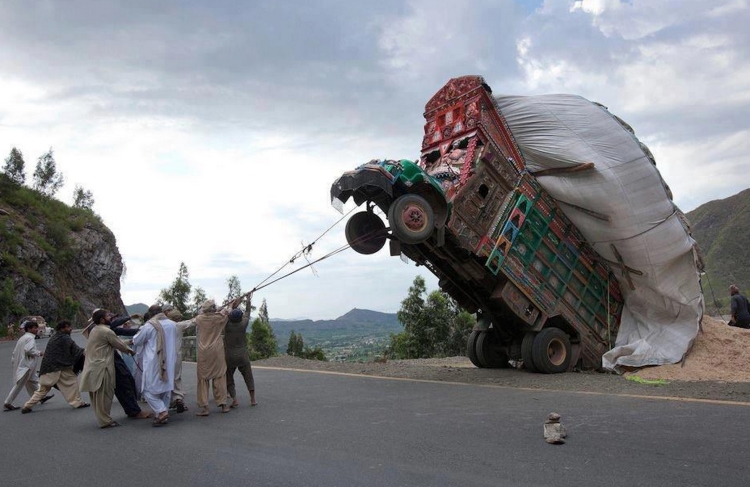The picture may be humorous for you, but it left us with a big question about citizen’s responsibility on road traffic safety.
Rangeinn spot this picture on social media; where a man recklessly riding a motorbike having a deep freezer upon it. Also can be seen that he is using a mobile phone which is strictly prohibited.
Recently; Rangeinn has published an article on a traffic violation by Police but not in all cases Police is fully responsible; the issue is from both side as citizens do not heed upon their responsibility and led to various road traffic accidents.
Over speeding, overloading, pillion riding, and other common road traffic safety hazards rules are commonly violated on the roads of Pakistan.
Citizens not only put their life at risk but also put other lives in danger just to save few seconds to few minutes, just to save a little amount of money.
According to Rescue 1122 Rawalpindi records; over -speeding is the topmost killer on our roads; carelessness, U-turns, wrong-turns, and tire bursts are other major contributors to road fatalities annually.
Whereas overloading also a major culprit to increase the fatality rate daily in Pakistan.
The cost of road accidents in Pakistan, both in terms of human lives and medical care as well as in terms of vehicle repairs; far exceeds the money the country begs for, from the IMF.
DEATH DUE TO ACCIDENTS EVERY FIVE MINUTES
The National Road Safety Strategy 2018-2030 produced by the Ministry of Communications states that in Pakistan traffic accidents take a human life after every five minutes.
Moreover, it projects an increase by about 77 percent in 2020 and 200 percent by 2030, if no new road safety action is taken.
Every year, the economy incurs a loss of around three percent of the Gross Domestic Product (GDP) in repairs of damages to vehicles and injuries caused by road accidents.
The World Health Organization’s (WHO) 2016 estimates throw up alarming numbers:
Annually 27,500 people die and 500,000 are injured on our roads.
Road accidents are a major cause of death among those aged 15-29 years, it states, terming overspeeding as a major high-risk factor.

DEATHS IN NUMBERS
Furthermore, the fatality rate and injuries per 100,000 population show an increasing trend in Pakistan, according to WHO.
The death rate on roads, which was 2.44 percent in 2012-13; has risen to 3.08 percent in 2017-18, NHMP data reveals.
Likewise, the rate of injuries on roads was 5.03 percent in 2012-13 and climbed up to 7.50 percent in 2017-18.
The Road Safety Strategy, while making future projections, states expected fatalities on roads can be more than 10,000 in 2020 and over 18,000 in 2030.
The NTRC documents, available with this correspondent; reflect a regular increase in the number of vehicles on roads in Pakistan.
Around two million vehicles registered annually in Pakistan.
The record shows an estimated 16 million [15,568,800] vehicles on the roads in 2015-2016 and this number goes up to an estimated 24 million [24,420,255] in 2017-18 and 25,365,061 in 2018-19.
PAKISTAN PENAL CODE STATEMENT AGAINST VIOLATION OF ROAD TRAFFIC SAFETY RULES :
Under section 320 of the Pakistan Penal Code;
If a person dies in a traffic accident, the accused may be imprisoned, and the sentence may extend to 10 years under the Diyat law.
Whereas the punishments for negligent and rash driving are effective; the procedure under the Code of Criminal Procedure (CrPC) is complicated and lengthy.
Section 279 of PPC describes rash driving as an offense, which is bailable but not compoundable.
It states: “Whoever drives any vehicle; or rides, on any public way in a manner so rash or negligent as to endanger human life. or to be likely to cause hurt or injury to any other person shall be punished with imprisonment of either description for a term which may extend to two years; or with fine which may extend to 3,000 rupees or with both.”
Pakistan is a signatory to the Central Asia Regional Economic Cooperation (CAREC) Road Safety Strategy 2017-2030;
Which sets an overall objective of reducing fatalities on CAREC corridors by 50 percent by 2030.
The accord binds the government to ensure a 50 percent reduction in road traffic crashes by 2030.
However, successful implementation of this international commitment depends upon the leadership’s strong political will; commitment, allocation of budgets, and effective coordination between the center and provincial governments.
Under existing circumstances, achieving even a 30 percent reduction in road traffic crashes seems difficult.
Pakistan has a decade to meet the set target but the government will have to take the lead to make national highways and motorways safe for travel.
The writer is Freelancer, associated with Medical Profession ,working towards PhD in Healthcare Management.







